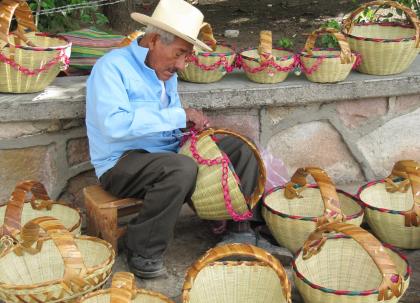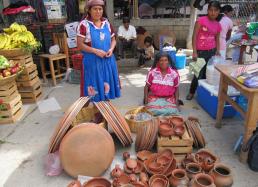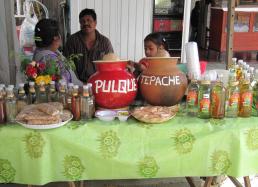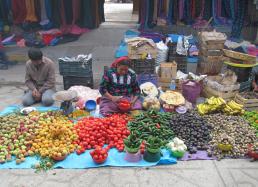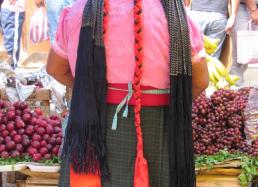13: The Tlacolula Market and Its Antecedents
Our time in the laboratory is wrapping up. The artifact analysis, illustration, photography, and coding are done for the season, and the preliminary report with the maps of each surface is about ready to copy. Next week, our artifact collections will be deposited in storage in Mitla, the preliminary report will be disseminated to the appropriate officials and institutions, and our North American crew will disperse, with most returning to their homes.
Linda and I will be staying down here another week to present a paper at the Monte Albán Roundtable, a biennial conference organized by Mexico’s National Institute of Anthropology and History (INAH). Just as, at the outset of each field season, we relish our annual pilgrimage to Monte Albán—one of Mexico’s first cities and the largest archaeological site in the Valley of Oaxaca—toward the end of our time here, we always try to make a visit to the Sunday market in Tlacolula.
Although far smaller than the current state capital of Oaxaca City, Tlacolula is the second biggest community (estimated 30,000 inhabitants) in the Valley of Oaxaca today, and it’s only 15 kilometers from Mitla, so Linda and I go there often for errands and to buy things that we cannot find in Mitla. On Sundays, Tlacolula’s populace doubles with its weekly market (see above photo.)
I made my first trip to this market more than 30 years ago, when it was sometimes jokingly referred to as “Tokyolula,” as you could find all kinds of Japanese electronic products that were contraband in Mexico at the time. Now, those items have been at least partly replaced by tools and plastic goods from China and ‘semi-nuevo’ (used) clothes from the U.S., all of which are interspersed in the market with locally made pottery, wooden goods, rugs, and, of course, all kinds food (cooked and uncooked, fresh and prepared—see Photos #1-4 below.)
In one sector, a wide assortment of lush flowers are sold, while elsewhere, the herbalists and curers display their powdery, leafy, and rooty wares, many of which most local Oaxacans would be hard pressed to tell you specifically how to employ. At one moment, you might pass women with ribbons in their hair and in traditional dress, who have traveled since the wee hours of the morning from their mountain villages (see Photo #5 below.) And then next, you might encounter a group of European and/or American tourists, who have just arrived in huge air-conditioned tour buses from Oaxaca City.
During the past 30 years, some of the kinds of items for sale in the market have changed, but the vibrancy, diversity, and rich range of colors on view have not. Over the course of the mid-20th century, the market system of Oaxaca drew the attention of several anthropologists, who documented the economic centrality of this institution to the people and life in the Valley of Oaxaca.
Some of these scholars speculated that marketplace exchanges likely had a long history in the region, but there wasn’t sufficient archaeological data available at that time to assess their hypothesis. In any event, the question of prehispanic marketing and markets in Oaxaca was left surprisingly unaddressed in the archaeological literature for decades.
When we think of market economies and marketplace exchanges, the mind tends to conjure Europe and its history. But Hernan Cortés and the conquering Spaniards in the 16th century actually raved about the size and activity of the main Aztec market at Tenochtitlán-Tlatelolco (the capital of the Aztec Empire). Even some of the Spanish who had been to Italy—the hotbed of European commerce at the time—said they never saw a market as grand and diverse as in the Aztec capital, where the din of market activity could be heard from kilometers away.
The Valley of Oaxaca never had a city as large as Tenochititlán, nor was it ever the heart of an imperial realm the size of that dominated by the Aztec, so a marketplace the size of the one in central Mexico would never be expected. But our expanding archaeological evidence from the later prehispanic eras in the Valley of Oaxaca is leading to a stronger case for the importance of markets and marketplace exchange in prehispanic Oaxaca. After all, a market system the size of the Aztec must have had antecedents and smaller analogs elsewhere in prehispanic Mesoamerica.
Unfortunately, definitive archaeological evidence for markets is hard to come by, and written texts concerning the economy predating the Spanish Conquest do not exist. Nevertheless, by excavating a significant sample of houses dating to the Valley of Oaxaca Classic period (ca. 300 - 900), we’ve begun to build a case that marketplace exchanges likely were important at that time. We’ve now excavated three residences at the Mitla Fortress, adding to the eight we studied at El Palmillo and one at the Ejutla site. In all twelve of these houses, we’ve noted goods that were not produced by that household’s inhabitants and other goods that appear to have been made for exchange.
Given this degree of involvement in exchange at the domestic scale, it seems unlikely that these kinds of economic activities could’ve been centrally managed or controlled. Rather, it seems likely that barter and marketplace exchanges helped move these goods between households at single sites and across larger regions. The vibrancy of markets in Oaxaca provides added indication that this institution is not a simple, recent introduction and likely has a long history, along with the Aztec market.
More soon,
Gary

